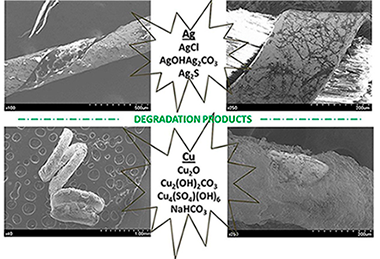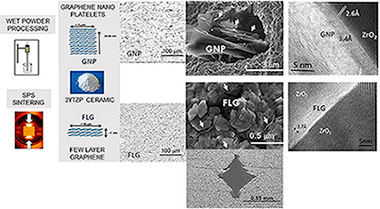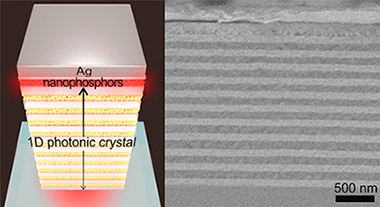Artículos SCI
2019
2019
Nanotecnología en Superficies y Plasma
XPS primary excitation spectra of Zn 2p, Fe 2p, and Ce 3d from ZnO, α‐Fe2O3, and CeO2
Pauly, N.; Yubero, F.; Espinós, J.P.; Tougaard, S.Surface and Interface Analysis, 51 (2019) 353-360
Show abstract ▽

Metal oxides are important for current development in nanotechnology. X‐ray photoelectron spectroscopy(XPS) is a widely used technique to study the oxidation states of metals, and a basic understanding of the photoexcitation process is important to obtain the full information from XPS. We have studied core level excitations of Zn 2p, Fe 2p, and Ce 3d photoelectron emissions from ZnO, α‐Fe2O3, and CeO2. Using an effective energy‐differential XPS inelastic‐scattering cross section evaluated within the semiclassical dielectric response model for XPS, we analysed the experimental spectra to determine the corresponding primary excitation spectra, ie, the initial excitation processes. We find that simple emission (Zn 2p) as well as complex multiplet photoemission spectra (Fe 2p and Ce 3d) can be quantitatively analysed with our procedure. Moreover, for α‐Fe2O3, it is possible to use the software package CTM4XAS (Charge Transfer Multiplet program for X‐ray Absorption Spectroscopy) to calculate its primary excitation spectrum within a quantum mechanical model, and it was found to be in good agreement with the spectrum determined by analysis of the experiment.
Marzo, 2019 | DOI: 10.1002/sia.6587
Degradation processes of historic metal threads used in some Spanish and Portuguese ornamentation pieces
Duran, A; Perez-Maqueda, R; Perez-Rodriguez, JLJournal of Cultural Heritage, 36 (2019) 135-142
Show abstract ▽

The degradation processes that occurred on metal threads applied in the embroidery used for clothing and in the ornamentation of sculptures, the Sevillian Holy Week processions, and Portuguese and Spanish palace and museum are thoroughly analyzed. Some threads from the 14th and 18–19th centuries were considered. In the metal threads, sulphur- and chlorine-based compounds were detected either individually or together, depending on the degradation process. Basic silver carbonate, sodium bicarbonate and copper-based compounds were also observed. The different degradation processes were attributed to different factors, such as environmental contamination, degradation of the fibrous cores, and inadequate cleaning and/or mechanical treatments.
Marzo, 2019 | DOI: 10.1016/j.culher.2018.09.006
Reactividad de Sólidos
Sample-Controlled analysis under high pressure for accelerated process studies
Perejon, A; Sanchez-Jimenez, PE; Soria-Hoyo, C; Valverde, JM; Criado, JM; Perez-Maqueda, LAJournal of the American Ceramic Society, 102 (2019) 1338-1346
Show abstract ▽

The potential of controlled rate thermal analysis (CRTA) for studying high-pressure gas-solid processes has been evaluated. CRTA is a type of smart temperature program based on a feedback system that uses any experimental signal related to the process evolution for commanding the temperature evolution. In this work, an instrument that uses the gravimetric signal for CRTA control has been designed and used for the study of two high-pressure gas-solid reactions: the highly exothermic thermal oxidation of TiC under high pressure of oxygen and the reduction in Fe2O3 under high pressure of hydrogen. Advantages of CRTA for discriminating overlapping processes and appraising kinetic reaction mechanisms are shown.
Marzo, 2019 | DOI: 10.1111/jace.15960
Reactividad de Sólidos - Tribología y Protección de Superficies
Microstructure, interfaces and properties of 3YTZP ceramic composites with 10 and 20 vol% different graphene-based nanostructures as fillers
Munoz-Ferreiro, C; Morales-Rodriguez, A; Rojas, TC; Jimenez-Pique, E; Lopez-Pernia, C; Poyato, R; Gallardo-Lopez, AJournal of Alloys and Compounds, 777 (2019) 213-224
Show abstract ▽

The graphene family comprises not only single layer graphene but also graphene-based nanomaterials (GBN), with remarkably different number of layers, lateral dimension and price. In this work, two of these GBN, namely graphene nanoplatelets (GNP) with n similar to 15-30 layers and few-layer graphene (FLG) with n < 3 layers have been evaluated as fillers in 3 mol% yttria stabilized tetragonal zirconia (3YTZP) ceramic composites. Composites with 10 and 20 vol% GNP or FLG have been fabricated by wet powder processing and spark plasma sintering (SPS) and the influence of the content and number of layers of the graphene-based filler has been assessed. For both graphene-based fillers, an intermediate zirconia oxycarbide has been detected in the grain boundaries. The lower stacking degree and much more homogeneous distribution of the FLG, revealed by transmission electron microscopy (TEM), can improve load transfer between the GBNs and the ceramic matrix. However, high FLG contents lower densification of the composites, due partly to the larger FLG interplanar spacing also estimated by TEM. The hardness (both Vickers and nanoindentation) and the elastic modulus decrease with increased GBN content and with improved graphene dispersion. The FLG greatly inhibit the crack propagation that occur perpendicular to their preferential orientation plane. The composites with thinner FLG have higher electrical conductivity than those with GNP. The highest electrical conductivity is achieved by composites with 20 vol% FLG in the direction perpendicular to the compression axis during sintering, sigma(perpendicular to) = 3400 +/- 500 Sm-1.
Marzo, 2019 | DOI: 10.1016/j.jallcom.2018.10.336
Materiales Ópticos Multifuncionales
Tamm Plasmons Directionally Enhance Rare-Earth Nanophosphor Emission
Geng, DL; Cabello-Olmo, E; Lozano, G; Miguez, HACS Photonics, 6 (2019) 634-641
Show abstract ▽

Rare-earth-based phosphors are the materials on which current solid-state lighting technology is built. However, their large crystal size impedes the tuning, optimization, or manipulation of emitted light that can be achieved by their integration in nanophotonic architectures. Herein we demonstrate a hybrid plasmonic-photonic architecture capable of both channeling in a specific direction and enhancing by eight times the emission radiated by a macroscopically wide layer of nanophosphors. In order to do so, a slab of rare-earth-based nanocrystals is inserted between a dielectric multilayer and a metal film, following a rational design that optimizes the coupling of nanophosphor emission to collective modes sustained by the metal-dielectric system. Our approach is advantageous for the optimization of solid-state lighting systems.
Marzo, 2019 | DOI: 10.1021/acsphotonics.8b01407
- ‹ anterior
- 139 of 420
- siguiente ›














